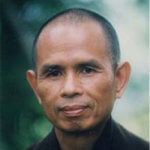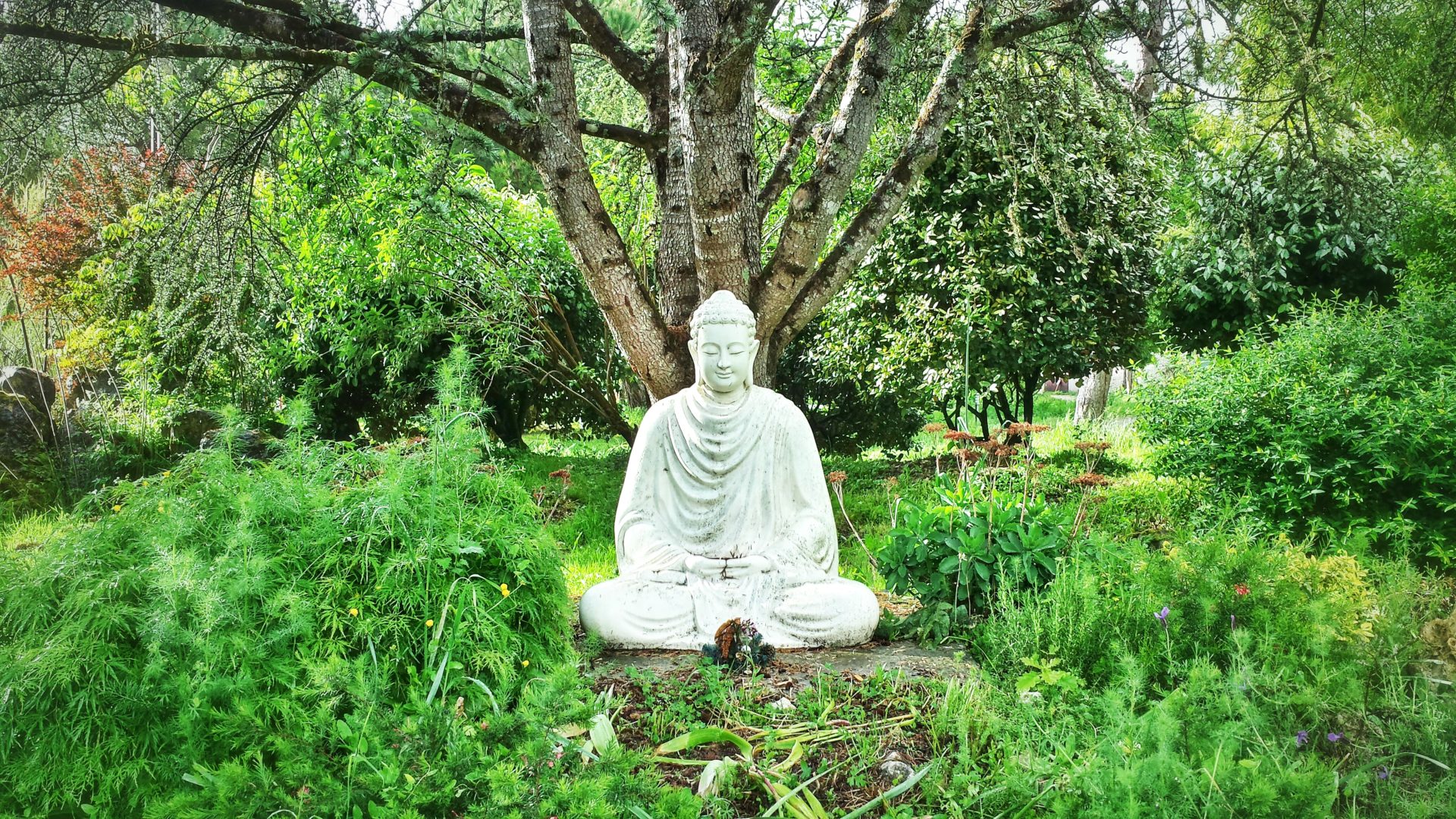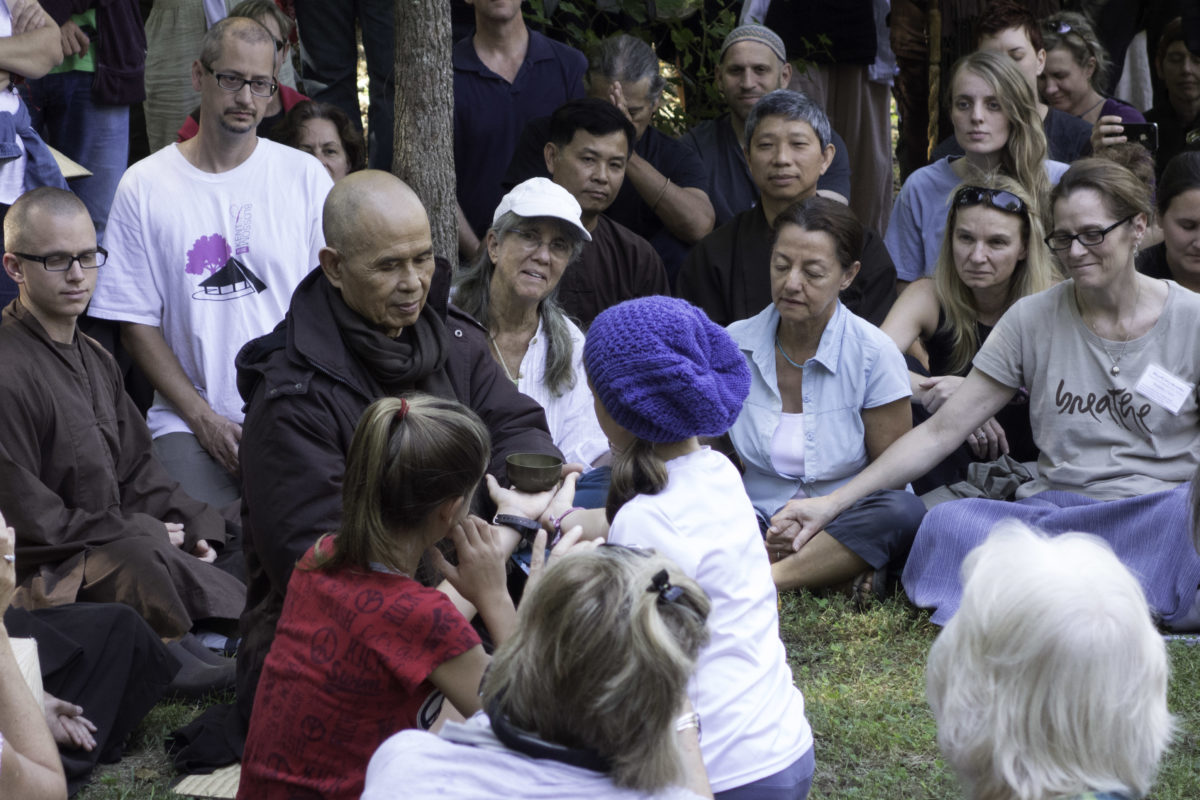
March 18, 2012
Plum Village
There is a big vacuum inside of us, so we look for things outside us to fill up the vacuum. We think that new and exciting things will work, but they do not seem to have an effect.
Good morning, dear Sangha. Today is Sunday, March the 18th in the year 2012,

March 18, 2012
Plum Village
There is a big vacuum inside of us, so we look for things outside us to fill up the vacuum. We think that new and exciting things will work, but they do not seem to have an effect.
Good morning, dear Sangha. Today is Sunday, March the 18th in the year 2012, and we are in the Upper Hamlet beginning our spring retreat. It is very nice to hear the sound of the rain.
Many of us know that eternity can be touched in this present moment and the cosmos can be seen in the palm of our hand. But we need some mindfulness and concentration to do this. When you practice the Ten Mindful Movements,1 you can touch eternity with every movement. If you are truly mindful, if you are truly concentrated, if you are able to release the notion of self, you are no longer this tiny body. You are the whole cosmos. Your tiny body contains the whole cosmos in it. All the generations of the past and the future are there in your tiny body and if you have that insight, it is easy to touch eternity in the present moment. When you breathe in mindfully with concentration, you can touch eternity. When you make a step mindfully with concentration, you can touch eternity and infinity.
We have received a number of questions concerning global ecological collapse from a magazine in London. Today we will try to answer some of them. Each question requires one in-breath and one out-breath, to be received.
- Do you believe humans can avoid a global ecological collapse, or are we driving ourselves towards one?
- The urban population across the world is growing. What, if anything, is lost by our increasing switch towards being an urban species?
- Are we a vulnerable species or one still in control of our destiny?
- There is strong support for engineered solutions to our ecological problems, for example, reflecting the sun’s rays, sucking up carbon emissions, or lab-grown Is this the right approach for us to be taking?
- Most of us in the West are still attached to a high-consumption lifestyle. We like to buy new and exciting things. Is there a strong enough alternative lifestyle out there that can convince us to leave this high-consumption lifestyle behind?
- Have we found a new narrative, one that can help us learn to live more sustainably before it is too late?
- What is the hardest part of the lifestyle you have chosen to lead, and how do you attract young people to follow?
- Can we strive for financial and spiritual contentment, or are they mutually exclusive? Can we be at the same time rich and spiritual?
- Most environmentalists narrow down the problems we face to two issues: overconsumption and overpopulation. Where do you stand?
We Are the Earth
I think that we should try to answer the first and the third questions because they are connected. 1. Do you believe humans can avoid a global ecological collapse, or are we driving ourselves towards one? 3. Are we a vulnerable species or one still in control of our destiny?
The National Wildlife Federation tells us that every day about one hundred plant and animal species are lost to deforestation. Extinction of species is taking place every day. In one year, there may be 200,000 species going into extinction. That is not a problem of the future; it’s going on now. We know that over 250 million years ago, there was global warming caused by gigantic volcanic eruptions. They caused the worst mass extinction in the history of the planet. At that time, there was a six-degree-centigrade increase in the global temperature. It was enough to kill up to ninety-five percent of the species that were alive on Earth. And now another global warming is taking place—this time, because of deforestation and industrialization, man-made. And maybe in one hundred years, there will be no more humans on the planet. Just one hundred years.
After the disappearance of ninety-five percent of species on Earth caused by that mass extinction, the Earth took one hundred million years to restore life as we see it now. If our civilization disappears, it will take that long for another civilization to reappear.
When volcanic eruptions happened, the carbon dioxide buildup created the greenhouse effect. That was more than 250 million years ago, and now the building up of carbon dioxide is coming from our own lifestyle and our industrial activities. And if a six-degree-centigrade increase takes place, ninety-five percent of the species on Earth will die out, including Homo sapiens. That is why we have to learn how to touch eternity with our in-breath and out-breath.
So mass extinctions of species have happened five times and the current one is the sixth. But according to Buddhist teaching, there is no birth and no death. After extinction, things will reappear in other forms. So we have to breathe very deeply to acknowledge the fact that we humans may disappear in just one hundred years. We have to learn to accept that hard fact. We should not be overwhelmed by despair. The solution is to learn how to touch eternity in the present moment.
We have been talking about the environment as something different from us, but we are the environment. The non-human elements are our environments and we are the environment of non-human elements. So we are one with the environment, we are the environment, we are the Earth. The Earth has the capacity to restore balance. Sometimes many, many species have to disappear in order for the balance to be restored.
The second question: The urban population across the world is growing. What is lost by our increasing switch towards being an urban species?
Life in the cities and life in the countryside are connected because we have to feed the cities. That is why the countryside has to change. The countryside is being contaminated by many things. The countryside has to use a lot of antibiotics, poisons, and insecticides to provide the cities with food. So the countryside is no longer safe for us. Even if we all returned to the countryside and continued that level of consumption, it is not a solution. Whether in the city or in the countryside, we are losing a lot. In the countryside we have more chances to touch nature. It is a little bit easier to heal ourselves with the practice of Touching the Earth in the countryside. But the countryside is also losing itself for the sake of the cities.
Transforming Our Lifestyle
The fourth question: There is strong support for engineered solutions to our ecological problems, like reflecting sunrays, sucking up carbon emissions, or lab-grown meat. Is this the right approach for us to be taking?
That may help, but it is not enough. What we need is a transformation of our consciousness, our idea of happiness, our lifestyle. And this is linked to the fifth question: Most of us in the West are still attached to a high-consumption lifestyle. In Asian countries, people are doing very much the same thing. We like to buy new and exciting things. Is there a strong enough alternative lifestyle out there that can convince us to leave this high-consumption lifestyle behind?
We are seeking happiness, but there is suffering inside of us. We are getting sick. We don’t feel at peace with ourselves. There is a big vacuum inside of us, so we look for things outside us to fill up the vacuum. We think that new and exciting things will work, but they do not seem to have an effect. We are consuming more and more, but we do not feel fulfillment. We need love, we need peace, but we do not know how to create love and peace. We know there must be a lifestyle that will create love and joy, but unless we know how to create that kind of life, we will continue to buy things.
Suppose you know how to enjoy walking meditation. With some training, you know how to bring your mind back to your body so that your mind and your body are together. When your mind and body are together, you are truly there. You can recognize that the rain is wonderful, the trees are beautiful, the air is fresh, and you can enjoy breathing in, breathing out, and touch the wonders of life in this present moment. In fact, if we bring our mind home to our body, if we know how to stop our thinking, then we will be established in the present moment. We are mindful of our body, we are mindful of what is going on in our body and around us, and we are in a situation to touch the wonders of life that are available in the here and the now. We are able to see that there are a lot of wonders in our body, in our mind. And when we reach out to the environment, we see that there are so many wonders also. This present moment is full of wonders. Because you don’t know how to touch these wonders, you don’t know how to appreciate life, to appreciate what is there. So you look for something that you think will make you happy.
Suppose we learn about the Five Mindfulness Trainings.2 The Five Mindfulness Trainings is a kind of lifestyle that is born from a vision called interbeing. Everything is connected to everything else. Your happiness and the happiness of other species inter-are. If you are healthy, if you are happy, then other forms of life can profit from you. If you are sick, if you suffer, then other species will have to suffer with you. That insight of interbeing helps you see that you are linked to everything else. To protect yourself, you have to protect nature and every other species. That insight of interbeing will help you to remove discrimination, fear, anger, and make you feel better in yourself. The Five Mindfulness Trainings help us to train in how to protect life.
Protecting Life
The first training is about protecting life. Your life and the lives of other species are interrelated, and when you try to protect the lives of other species, you protect your own life. In order to protect ourselves, we have to protect others and that is the practice of the First Mindfulness Training.
When you breathe in mindfully, you can see that Mother Earth is in you, and you are in Mother Earth. And that kind of insight helps you to remove your fear of dying. It helps you to see that to protect yourself, you have to protect Mother Earth. Protecting Mother Earth is to protect yourself. Protecting other species is protecting oneself. This is very clear. That is the first of the Five Mindfulness Trainings.
If you think you are intelligent enough as a species, then you may be able to use your talent, your technologies, your love, your insight to protect the lives of other species. And even if you are the youngest species on Earth, you can play the role of an elder brother, an elder sister, and try to look out for the well-being of other species. This is a very beautiful thing to do. And that is what Mother Earth is expecting you to do as a species on earth, the Homo sapiens. Protecting life is a joy. That is a kind of lifestyle that comes from the insight of interbeing.
You are not doing it for yourself, because life is one. Life cannot be chopped into several pieces. To live in such a way that helps you to protect life can bring you a lot of joy because that is love itself. And when you have love in yourself, you don’t have to run and buy things, because love is fulfilling. Love makes you peaceful and happy.
Your happiness and the happiness of other species inter-are. If you are healthy, if you are happy, then other
forms of life can profit from you. If you are sick, if you suffer, then other species will have to suffer with you.
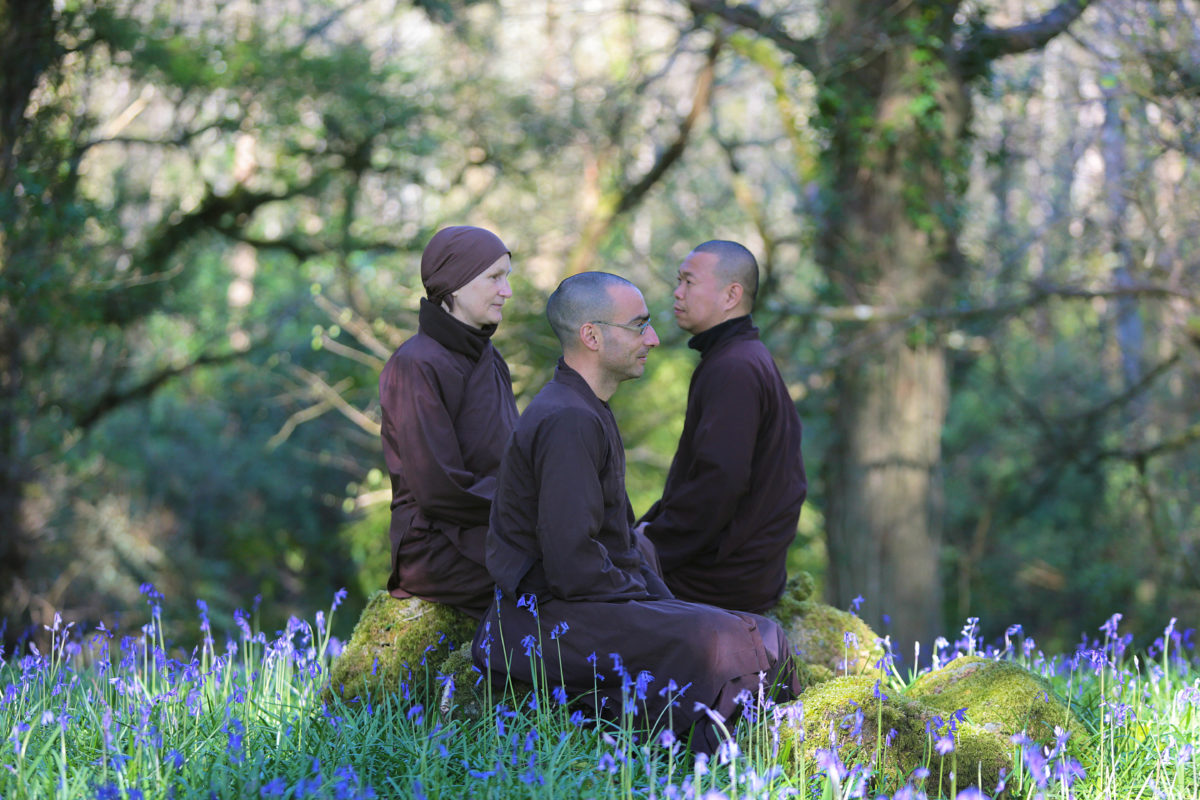
Generating True Love and True Happiness
The Third Mindfulness Training is about cultivating true love. We have to learn how to generate the energy of loving-kindness, compassion, joy, and inclusiveness. This is the art of loving. If you are busy, if you only think of consuming, how do you have the time to love?
We learn from the Third Mindfulness Training that sexual desire and love are two different things. Love can only build, heal, rebuild, heal. We have to learn how to love ourselves. We have to learn how to take care of our body, to release the tension in our body, to reduce the pain in our body. There are very concrete ways to do it. You know how to practice touching the Earth by walking meditation, by lying down, allowing nature to heal you. You know how to release the tension in your body, to reduce the pain in your body, not to work your body too hard. All these things we can do. But if you are so busy making money in order to buy things, how do you have time to do so?
There are those of us who know how to organize our life in such a way that we have enough time to love, to take care of ourselves, and to take care of others around us. Every time you understand the suffering in yourself and in the other person, you allow the energy of compassion to arise in you. Every time we look deeply into the nature of suffering and see the causes of that suffering, compassion will be born in us as a kind of energy, whether that suffering is in us or in the other person. So getting in touch with suffering and allowing the energy of compassion to arise is something that we can do, provided that we are not so busy making money and buying things.
The energy of compassion can heal us and heal the other person and heal the Earth. Learning how to generate a feeling of joy, of happiness by touching the wonders of life, generating compassion by touching suffering, understanding suffering, are things all of us can do that belong to the kind of lifestyle that can heal ourselves and heal the Earth. The third training is about true love and this is possible if we have the time to practice as a group of people, a Sangha.
The Second Mindfulness Training is about true happiness. We realize that happiness cannot be possible with only making money and buying things. We should know how to generate and create true happiness. This training proves that true happiness is possible. We should stop running after fame, power, wealth, and sensual pleasures. We should recognize the wonders of life that are available in the present moment. We should be able to help ourselves and other people suffer less. These are concrete things to do as part of the lifestyle we are looking for.
Restoring Communication
The Fourth Mindfulness Training is about how to restore communication between father and son, father and daughter, mother and son, mother and daughter, partner and partner, brother and brother, brother and sister, and so on. If we cannot communicate, we suffer. Very often we cannot communicate with our own self. You don’t like yourself, you hate yourself, you don’t know how to listen to yourself, you don’t know how to help yourself. So the practice of loving speech and deep listening should be also directed to ourselves. We have to learn to listen to the deepest desire in ourselves, to listen to the suffering in ourselves in order to understand. When we have understood our suffering and our deepest aspiration, we will be able to listen and to understand the aspiration and the suffering of the other person. This is something we can do. This is the object of the Fourth Mindfulness Training.
We are deeply divided as a society. We are trying to kill each other and the killing is taking place everywhere. We have a lot of fear, anger, discrimination, and despair because there is not enough communication between members of our species. We are not only killing other species, we are killing ourselves as a species. That is why technology is not enough. We have to learn how to listen, how to speak lovingly.
We know that in five or six days, our practice in a retreat can help us to know how to listen to the suffering in us and in the other person and how to understand. When the energy of compassion is born, we’ll be able to listen with compassion and to use loving speech and restore communication. Every one of us can do that. This always happens in our retreats and this is part of the lifestyle you are looking for. This is a noble style of living and you don’t need to be a Buddhist in order to adopt this kind of lifestyle.
Mindful Consumption
The Fifth Mindfulness Training is about nourishment and healing. All of us need nourishment and healing. Most of us are sick. We don’t know how to go back to nature and get healing. We don’t know how to generate the energy of compassion and joy in order to heal ourselves. We rely only on medicines, antibiotics, surgery.
Mindful consumption is the way out, to respond to the fifth question. The sixth question is the same.
Nourishing Brotherhood and Sisterhood
The seventh question: What is the hardest part of the lifestyle you have chosen to lead? And how do you attract young people to follow?
I don’t think I have deprived myself of anything I like by choosing to be a monk. In fact, I enjoy the life of a monk. When we follow a vegetarian diet, we are very happy and we don’t suffer because we don’t eat meat and drink alcohol. We are fortunate to be able to eat vegetarian because we know that we don’t have to eat the flesh of other species in order to be alive. You can help protect life by eating. We have to learn to eat in such a way that can preserve our planet and reduce the suffering of living beings. That is why eating vegetarian can be a great joy, especially when you know how to cook.
The life of a monk is much easier than the life of a lay practitioner because as a monk you live in a community and you follow the community in sitting meditation, walking meditation, eating on time. We don’t deprive ourselves of anything. In fact, we have a lot of joy living together. We have a lot of time to build brotherhood and sisterhood and that sustains us. Romantic love cannot last as long as brotherhood and sisterhood. We should not continue to rush into the cities, but we should try to create communities in the countryside like Plum Village. You can create a lay community. It’s not necessary to be a Buddhist community. We can organize like in a kibbutz and share our cars, our tractors.
The presence of children in a community is very wonderful, and you don’t have to be father and mother in order to enjoy the presence of young people or children. I became a monk at the age of sixteen. I don’t feel that I suffer because I don’t have children, because I have so many spiritual children, monastic and lay. I enjoy very much doing sitting meditation and walking meditation with them. In our retreats, children enjoy holding my hand and doing walking meditation. I don’t feel that I am deprived of having children. In a community even if you don’t have children you can look at children of other couples as your own children. You can establish your own school where you can teach them the Five Mindfulness Trainings, the art of being happy, how to breathe, how to relax, how to build brotherhood and sisterhood starting in early life.
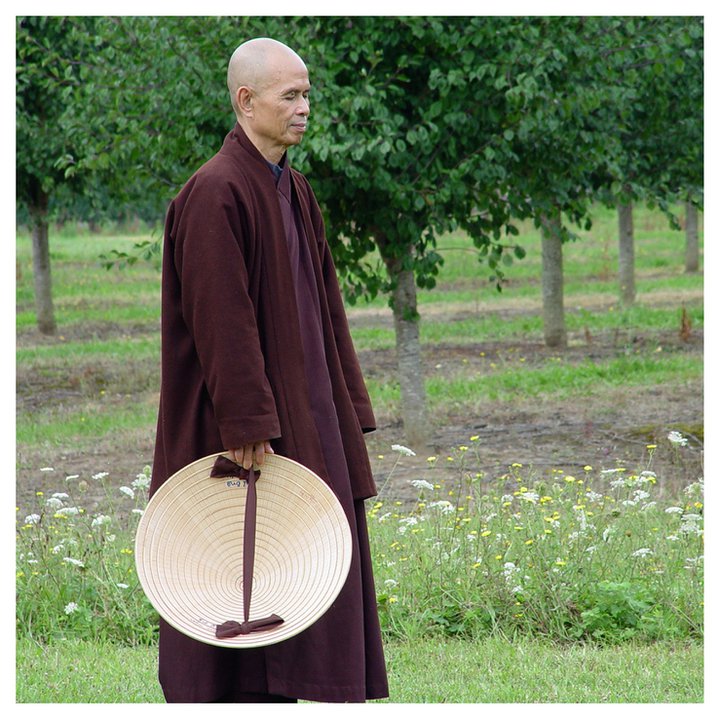
We can establish communities like Plum Village, a few hundred people living together. We share apartments, houses, cars. Living as a community of two or three hundred people, you can reduce the number of cars by two thirds.
The hardest thing may be to learn how to say no to requests of having retreats, of organizing retreats. This is the most difficult thing we in Plum Village have to face. Everywhere people ask us to come and organize a retreat, but we cannot always say yes. Our heart is broken when we have to say no, but we have to preserve ourselves to continue for a longer time. If there is one hard thing in our life, it is to say no, because the need to have retreats is felt very clearly everywhere.
How do you attract young people to follow? We don’t try to attract young people at all; they just come. Many of the young people have experienced romantic love and they have suffered. When they come to our retreats, they see that there is brotherhood and sisterhood. That is what we need the most in our life. We can be ourselves, we can be nourished by the energy of brotherhood and sisterhood.
To create a community and to build brotherhood and sisterhood to nourish us is a very important thing. You can devote your life to doing so. Instead of going to big cities and breathing air that is polluted, we can create many small communities in the countryside and try to live in a way that can help protect Mother Earth. We can work, we can garden together like in Plum Village. You can use your talent to serve the community, building brotherhood and sisterhood. The Five Mindfulness Trainings will be the directive, representing the lifestyle. If young people come to us, it is not because of the Dharma talk we offer; it is the joy, the happiness generated by brotherhood and sisterhood. Our daily practice is to generate the energy of love, brotherhood, and sisterhood.
Establishing small communities like that, we will truly generate the energy of brotherhood, sisterhood. Young people are capable of seeing that. Many of them will devote their lives to Sangha building to help generate the energy that you cannot buy in supermarkets.
Profiting from the Practice
The eighth question: Can we strive for financial and spiritual contentment, or are they mutually exclusive? That means, can you be both rich and spiritual?
Do we need to be rich? Do we need to make money? In Plum Village we also need money, but not to buy things, to consume things. We seek financial support not for buying new and exciting things but to have more places for practitioners to stay during a retreat, or to bring more monastics to a retreat, or to build a meditation hall, or to build monastic quarters. When we go to a city, we need money to buy tickets for Dharma teachers, monastic brothers and sisters, because we know that transformation and healing in a retreat requires the presence of enough Dharma teachers and monastic practitioners.
It’s very clear that spiritual practice can bring a lot of happiness and love and fulfillment. You don’t need a lot of money to be happy. If there is more financial help, then many more people will profit from the practice. If we are limited by financial conditions, the number of practitioners will not increase. But we do not sacrifice our practice, our spiritual life for the sake of financial realization.
Acting on Two Levels
There is one more question: Most environmentalists narrow down the problems we face to two issues, overconsumption and overpopulation. Where do you stand?
Of course we have to reduce consumption. We have to consume in such a way that can reduce the suffering of species on Earth. This is very clear. But we have to reduce the population also. To be a monk or a nun is one of the ways to reduce overpopulation, so I am calling for you to join us as monks and nuns. And if we can create small communities, and we can establish schools and take care of the children of other couples, we don’t miss our children. Although I do not have blood children, I feel that I have a lot of children, and they give me a lot of joy and energy and freshness. I think we have to act on two levels: we have to go down in consumption and go down in population, and this is possible. And we don’t have to deprive ourselves of anything, including the presence of children in our life.
